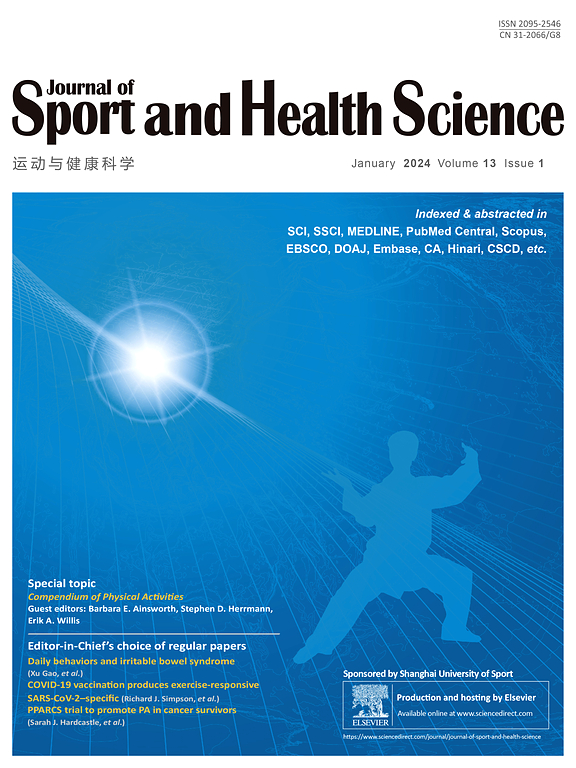Content validation of the Global Adolescent and Child Physical Activity Questionnaire (GAC-PAQ) in low-, middle-, and high-income countries across 6 continents.
IF 10.3
1区 医学
Q1 HOSPITALITY, LEISURE, SPORT & TOURISM
引用次数: 0
Abstract
BACKGROUND Investigators from low-, middle-, and high-income countries representing 6 continents contributed to the development of the Global Adolescent and Child Physical Activity Questionnaire (GAC-PAQ). The GAC-PAQ is designed to assess physical activity (PA) across all key domains (i.e., school, chores, work/volunteering, transport, free time, outdoor time). It aims to address multiple gaps in global PA surveillance (e.g., omission of important PA domains, insufficient cultural adaptation, underrepresentation of rural areas in questionnaire validation studies).The purpose of this study was to assess the content validity of the GAC-PAQ among PA experts, 8- to 17-year-olds, and one of their parents/guardians, and to discuss changes made to the questionnaire based on participants' feedback. METHODS Sixty-two experts in PA measurement and/or surveillance from 24 countries completed an online survey that included both closed- and open-ended questions about the content validity of the GAC-PAQ. The proportion of experts who agreed or strongly agreed with the items was calculated. Child-parent/guardian dyads from 15 countries (n = 250; 10-40 per country) participated in a structured cognitive interview to assess the clarity of the questions and response options, and they were encouraged to provide suggestions to improve clarity and facilitate completion of the questionnaire. Participating countries are: Aotearoa New Zealand, Brazil, Canada, China, Colombia, Czech Republic, India, Malawi, Mexico, Nepal, Nigeria, Spain, Sweden, Thailand, and the United Arab Emirates. Interviews were conducted in 13 different languages and structured by PA domain. Generic images were included to help participants in answering questions about PA intensity. RESULTS Expert agreement with the items for each domain exceeded 75%, and their qualitative feedback was used to revise the questionnaire before cognitive interviews. In general, participants found the questionnaire to be comprehensive. Adolescents (12-17 years) found it easier than children (8-11 years) to answer the questions. Several children struggled to answer questions about the duration and intensity of activities and/or concepts related to travel modes, active trips, and organized activities. Many parents/guardians were unsure about the frequency, duration, and intensity of their children's or adolescents' PA at school and/or recommended using more culturally relevant and appropriate images. Some participants misunderstood the concept of activities that "make you stronger" (intended to assess resistance activities) and/or struggled to differentiate between work, volunteering, and chores. CONCLUSION Participants' feedback was used to develop a revised, simplified, and culturally adapted GAC-PAQ, which will be pilot-tested in all 15 countries in an App that will include country-specific images and narration in local languages. Further research is needed to assess the reliability and validity of the revised GAC-PAQ.全球青少年和儿童身体活动问卷(GAC-PAQ)在六大洲低、中、高收入国家的内容验证
来自六大洲的低收入、中等收入和高收入国家的调查人员参与了全球青少年和儿童身体活动问卷(GAC-PAQ)的编制。GAC-PAQ旨在评估所有关键领域(即学校,家务,工作/志愿服务,交通,空闲时间,户外时间)的身体活动(PA)。它旨在解决全球PA监测中的多个差距(例如,遗漏重要的PA领域,文化适应不足,问卷验证研究中农村地区代表性不足)。本研究的目的是评估PA专家、8- 17岁青少年及其家长/监护人的GAC-PAQ内容效度,并根据参与者的反馈意见讨论问卷的修改。方法来自24个国家的62位PA测量和/或监测专家完成了一项在线调查,其中包括关于GAC-PAQ内容有效性的封闭式和开放式问题。计算了同意或强烈同意这些项目的专家的比例。来自15个国家的子女-父母/监护人(n = 250;(每个国家10-40人)参加了一次结构化的认知访谈,以评估问题的清晰度和备选答案,并鼓励他们提出建议,以提高清晰度和促进完成调查表。参与国有:新西兰、巴西、加拿大、中国、哥伦比亚、捷克共和国、印度、马拉维、墨西哥、尼泊尔、尼日利亚、西班牙、瑞典、泰国和阿拉伯联合酋长国。访谈以13种不同的语言进行,并按PA域组织。通用图像被纳入帮助参与者回答关于PA强度的问题。结果专家对各领域项目的认同度均超过75%,并在认知访谈前利用他们的定性反馈对问卷进行修改。总的来说,参与者认为问卷是全面的。12-17岁的青少年比8-11岁的儿童更容易回答这些问题。一些孩子很难回答有关活动的持续时间和强度以及/或与旅行模式、主动旅行和有组织的活动相关的概念的问题。许多家长/监护人不确定他们的孩子或青少年在学校的PA的频率,持续时间和强度,并/或建议使用更具文化相关性和适当的图像。一些参与者误解了“让你更强大”活动的概念(旨在评估抵抗活动)和/或难以区分工作,志愿服务和家务。参与者的反馈被用于开发经过修订、简化和适应文化的GAC-PAQ,该GAC-PAQ将在所有15个国家的一个应用程序中进行试点测试,该应用程序将包括国家特定的图像和当地语言的叙述。修订后的GAC-PAQ的信度和效度有待进一步研究。
本文章由计算机程序翻译,如有差异,请以英文原文为准。
求助全文
约1分钟内获得全文
求助全文
来源期刊

Journal of Sport and Health Science
SPORT SCIENCES-
CiteScore
18.30
自引率
1.70%
发文量
101
审稿时长
22 weeks
期刊介绍:
The Journal of Sport and Health Science (JSHS) is an international, multidisciplinary journal that aims to advance the fields of sport, exercise, physical activity, and health sciences. Published by Elsevier B.V. on behalf of Shanghai University of Sport, JSHS is dedicated to promoting original and impactful research, as well as topical reviews, editorials, opinions, and commentary papers.
With a focus on physical and mental health, injury and disease prevention, traditional Chinese exercise, and human performance, JSHS offers a platform for scholars and researchers to share their findings and contribute to the advancement of these fields. Our journal is peer-reviewed, ensuring that all published works meet the highest academic standards.
Supported by a carefully selected international editorial board, JSHS upholds impeccable integrity and provides an efficient publication platform. We invite submissions from scholars and researchers worldwide, and we are committed to disseminating insightful and influential research in the field of sport and health science.
 求助内容:
求助内容: 应助结果提醒方式:
应助结果提醒方式:


